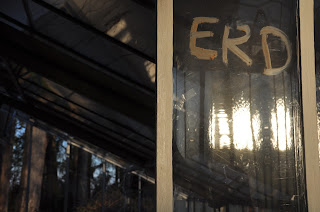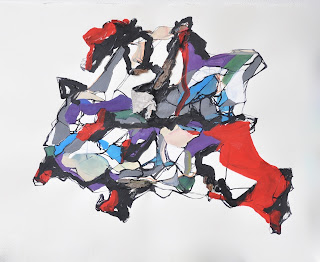We gathered at the Villa Walberta to review samplings to be adapted to our performance of The Anthropo Zen Girls. We had decided on the live element in the process to provide an exploration of the anthropocene at a primal level. The framing of our performance at a gallery institution to conduct the performance and discourse of the work.
A 6-month process to prepare and investigate the effects of a new world in the Anthropocene and what the Unknown Land would possibly result in. The project includes a collaborative project, exhibition and performance in Munich Germany in cooperation with the International Künstlerhaus Villa Waldberta of Munich (http://www.villa-waldberta.de)
Sunday, June 5, 2016
Research and Making: Waldberta - The Importance of time and Space in Art Making
Villa Waldberta - my office for research
An artist really gets the opportunity to experience the fundamentals of space and time at an artist residency. This is truly the gift of being at a residency. There is an adjustment that occurs in slowing life down and allow for the time for creativity -- free time is truly the essence of being an artist. Time to write, experiment, glean ideas and strategies that give life to the process of art making and to translate ideas into tangible form
Living the North American lifestyle is exhausting for me. It seems the "fast-food Nation" seeps into all levels of existence. The essence of creative contemplation becomes generated into a defined time slot with limited duration. Eventually, the pressure of basic day to day existence compresses that creative space, eventually being pushed into the next day or week, to become a trade off to living life in a tumultuous economy (equating to having food on the table and a roof overhead vs "being" an artist which for many is also connected to bank debt load from many years of fine arts education).
The European lifestyle is more humane containing a ridiculous amount of vacation time for the average occupation as well as a sincere respect for the life of an artist. When asking a European about these ideas they still reply that it still doesn't seem like they have enough time. I know nothing is perfect but slowing things down is certainly a beginning to restore the essential traits of humanity.
Such a great place for contemplation: Waldberta
Work Process: Going to the Munich Flea Market to obtain essential for art making - in my case it was to pick up a cheap amplifier. (5 Euros)
interesting fact/perhaps?
"flea market" is a common English calaq from the French "marché aux puces" (literally "market of the fleas"). The first reference to this term appeared in two conflicting stories about a location in Paris, France in the 1860s which was known as the marché aux puces (flea market).
The traditional and most-publicised story is "What Is A Flea Market?" by Albert LaFarge in the 1998 winter edition of Today's Flea Market magazine: "There is a general agreement that the term "Flea Market" is a literal translation of the French marché aux puces, an outdoor bazaar in Paris, France, named after those pesky little parasites of the order Siphonaptera (or "wingless bloodsucker") that infested the upholstery of old furniture brought out for sale."
The second story appeared in the book Flea Markets, published in Europe by Chartwell Books, has in its introduction:
In the time of the Emperor Napoleon III, the imperial architect Haussmann made plans for the broad, straight boulevards with rows of square houses in the center of Paris, along which army divisions could march with much pompous noise. The plans forced many dealers in second-hand goods to flee their old dwellings; the alleys and slums were demolished. These dislodged merchants were, however, allowed to continue selling their wares undisturbed right in the north of Paris, just outside the former fort, in front of the gate Porte de Clignancourt. The first stalls were erected in about 1860. The gathering together of all these exiles from the slums of Paris was soon given the name "marché aux puces", meaning "flea market"
____________________________________________________________
Frankie at the Villa was great source of obtaining objects for art making.
small reference making
painting and collage building
______________________________________________________________________
Thoughts of aesthetic principals in art. Heidegger comes to mind of course. interesting article in Philosophy Now by Reneh Karamians.
Dasein And The Arts
So how do you apply philosophical principles to think about art? An example can be derived from an unlikely source. Reneh Karamians uses Heidegger’s philosophy as an illustration of how to understand aesthetic experience.
Martin Heidegger gave philosophy a new description of humanity. No longer was mankind defined in terms of mind distinct from the physical world, as in Cartesian thought for example, but rather as being-in-the-world. Heidegger described ‘being’ as the essence of humanity, and employed the term ‘Dasein’ (German for ‘being-there’) to describe our existence.
This idea of being as the essence of humanity is not difficult to understand. It’s the realization that the essence of human existence is not to be found in our corporeality, as it would be for a physical object existing in space and time, but rather, in a certain type of experience of existing. Therefore, when Heidegger refers to humanity as Dasein or being-there, he is referring to the human experience of existing rather than to a person’s physical location in space and time, which is irrelevant when discussing the essential nature of humanity. To clarify the term ‘being’, one might further say that being is the totality of experience during any given unit of time.
‘Being in love’ is an excellent intuitive example of how this works, for the term makes no reference to existence in time or space, but rather to a specific state of being, namely love. So ‘being in love’ refers to the mode of being which is love, and this mode of being is the totality of the experience of love at precisely the time of the experience.
For any aware being which can be referred to as Dasein comes the realization of its own temporal existence. Sooner or later, it realizes it is mortal, that its time is limited. With this realization comes what Heidegger calls “being-towards-death”, which experience occurs through the mood of anxiety. Anxiety reveals time, which seems to be pushing Dasein to its end, and to the ‘nothingness’ (note: no-thing-ness) of death. Once this understanding of time and death is realized, the person, Dasein, exists in what Heidegger [perhaps unfortunately] calls an ‘authentic’ state of being. However, this authentic state does not last, for one gradually escapes it by finding refuge in a ‘public self’. This is the self who goes to work, makes dinner, mends the fence, etc. This type of escape from authenticity and the authentic self is called by Heidegger ‘inauthenticity’.
Let us now apply these ideas to the arts.
Dasein and Music
The idea of Heideggerian inauthenticity reveals a novel interpretation of music. Any inquiry into the essence of music can only reveal temporality, for at the very basis of music is rhythm, which is fundamentally a division of time using sound. Therefore music is essentially temporal. So to address the question “Why do we appreciate music?” one need only look as far as the inauthentic self. For wouldn’t any involvement in this sort of activity give one the false impression of a certain harmonywith time? Doesn’t the uniformity of the rhythm make time less offensive to Dasein, who otherwise must live face-to-face with death? One might even go as far as to say that rhythm presents a false sense of control over time. By creating the illusion of control over or harmony with time, music softens the idea of inevitable death, since time is the phenomenon through which Dasein reaches death. Put simply, any activity which presents time in a less threatening manner, as music does, provides the illusion of escape from time and therefore escape from anxiety and the no-thing. And if Dasein can escape the effects of time, then Dasein in a way, eludes death!
To understand this idea one need only hear music, or even mentally project (‘imagine’) the experience of hearing music. There is a certain non-conscious soothing character provided by the rhythm. This rhythm, this even division of time through sound, presents time in a non-threatening manner, giving Dasein the escape he/she so often attempts to make from authenticity.
Although I am in no way suggesting that this is the last word about the human fascination with music, I offer this idea as a primordial reason for the innate human love of music. So Heideggerian thought could very well hold the key to the human interest in musical experience.
Dasein and Poetry
The human love of poetry can be accounted for in basically the same way. Firstly, the rhythm of most poetic styles again causes a division of time; now through the use of words and syllables. Therefore, rhythmic poetry is, like music, a temporal entity by which Dasein is again offered an easy decline (or release) into inauthenticity. Some psychologists, such as Julian Jaynes, even believe that the rhythmic nature of certain poems have soothing effects on the brain. In his work, The Origin of Consciousness in the Break-down of the Bicameral Mind (1976), Jaynes states, “the function of meter in poetry is to drive the electrical impulses of the brain, and most certainly to relax the normal emotional inhibitions of both chanter and listener.”
Secondly, the sentimental nature of poetry offers Dasein an emotional escape from anxiety. This occurs in many ways. For example, nostalgic remembrance can take one’s experience back to a pleasantly inauthentic point in one’s being. More commonly, Dasein can be manipulated sentimentally into various other modes of being, such as, loving, fearing or lusting for example. These again guide Dasein’s being away from anxiety and cause a pleasant inauthenticity.
Dasein And The Visual Arts
Though the visual arts such as painting are not temporal in any way, they do however motivate emotion. Therefore, at times the visual arts can once again guide Dasein away from anxiety through the manipulation of sentiment. The creation and admiration of visual art also lead to inauthentic being in other ways. To understand this idea, one need only observe patrons at a local art gallery or local museum, as they busily discuss the technical points of the artwork being critiqued. Heidegger himself talks about such behavior in his work Being and Time (1962): he considers discussions taking place concerning the use of color, light, shade, etc, as one attempts to prove one’s self in the eyes of the other. This behavior is the very essence of inauthenticity, and once again, Dasein is making use of the arts to plunge into an inauthentic state of being. However, the visual arts can also postpone one’s boredom. According to Heidegger, this stimulation of thoughtfulness can lead to anxiety and therefore to authentic being.
© Reneh Karamians 2006
Subscribe to:
Comments (Atom)







































